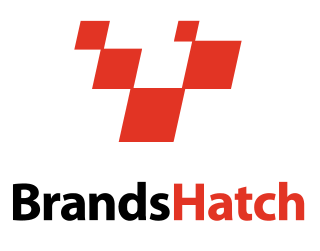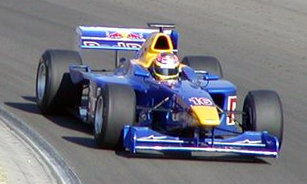
The Formula 3000 International Championship was a motor racing series created by the Fédération Internationale de l'Automobile (FIA) in 1985 to become the final preparatory step for drivers hoping to enter Formula One. Formula Two had become too expensive, and was dominated by works-run cars with factory engines; the hope was that Formula 3000 would offer quicker, cheaper, more open racing. The series began as an open specification, then tyres were standardized from 1986 onwards, followed by engines and chassis in 1996. The series ran annually until 2004, and was replaced in 2005 by the GP2 Series.

Formula Two is a type of open-wheel formula racing category first codified in 1948. It was replaced in 1985 by Formula 3000, but revived by the FIA from 2009–2012 in the form of the FIA Formula Two Championship. The name returned in 2017 when the former GP2 Series became known as the FIA Formula 2 Championship.
Lola Cars International Ltd. was a British race car engineering company in operation from 1958 to 2012. The company was founded by Eric Broadley in Bromley, England, before moving to new premises in Slough, Buckinghamshire and finally Huntingdon, Cambridgeshire, and endured for more than fifty years to become one of the oldest and largest manufacturers of racing cars in the world. Lola Cars started by building small front-engined sports cars, and branched out into Formula Junior cars before diversifying into a wider range of sporting vehicles. Lola was acquired by Martin Birrane in 1998 after the unsuccessful MasterCard Lola attempt at Formula One.

Brands Hatch is a motor racing circuit in West Kingsdown, Kent, England, United Kingdom. Originally used as a grasstrack motorcycle circuit on farmland, it hosted 12 runnings of the British Grand Prix between 1964 and 1986 and currently hosts many British and International racing events. The venue is owned and operated by Jonathan Palmer's MotorSport Vision organisation.

Jonathan Charles Palmer is a British businessman and former Formula One racing driver. Before opting for a career in motor racing, Palmer trained as a physician at London's Guys Hospital. He also worked as a junior physician at Cuckfield and Brighton hospitals.
Connew Racing Team, commonly known as Connew, was a short lived British Formula One constructor. Founded in 1971 by Peter Connew, the team constructed a single car, the PC1. The first monococque had to be aborted due to a change in regulations and the second tub was known as PC2. However, record books show the car driven by Migault and others as PC1. The intent was to compete in the Formula One World Championship in 1972, but a lack of financial and technical resources meant that the car only managed to start in one championship race, the 1972 Austrian Grand Prix, with French driver François Migault at the wheel. Following the Austrian race, the car competed in a handful of non-championship races before being converted to meet Formula 5000 specifications for the 1973 season. The chassis was damaged beyond repair during the season finale at Brands Hatch and the team closed.
Spirit Racing was a racing car constructor and racing team from the United Kingdom. Founded in 1981, it participated in the 1982 European Formula Two Championship, then in Formula One between 1983 and 1985, before competing in the 1988 F3000 season before finally folding at the end of the year. In 26 F1 races, its best finish was seventh at the 1983 Dutch Grand Prix.

Formula racing is any of several forms of open-wheeled single-seater motorsport. The origin of the term lies in the nomenclature that was adopted by the FIA for all of its post-World War II single-seater regulations, or formulae. The best known of these formulae are Formula One, Formula E, Formula Two, Formula Three, regional Formula Three and Formula Four. Common usage of "formula racing" encompasses other single-seater series, including the GP2 Series, which replaced Formula 3000.

Formula Ford, also known as F1600 and Formula F, is an entry-level class of single seater, open-wheel formula racing. The various championships held across the world form an important step for many prospective Formula One drivers. Formula Ford has traditionally been regarded as the first major stepping stone into formula racing after karting. The series typically sees career-minded drivers enter alongside amateurs and enthusiasts. Success in Formula Ford can lead directly to other junior formula series such as a Formula Renault 2.0 and Formula Three, or the W Series for female drivers.

The Euroformula Open Championship is a junior formula racing series based in Spain. It was one of six national and international Formula Three championships in Europe and Scandinavia that together used to form an important part of the established "career ladder" below Formula One. The championship's first season was held in 2001. In 2006, it was branded as the Spanish F3 Championship by Toyota, in deference to its sole engine supplier. In 2020, the championship ceased to be a F3-championship and will share its specifications with Japan's Super Formula Lights based on the previous-generation Formula Three standards, primarily with a choice of engines.

The International Trophy is a prize awarded annually by the British Racing Drivers' Club to the winner of a motor race held at the Silverstone Circuit, England. For many years it formed the premier non-championship Formula One event in Britain, alongside the Race of Champions at Brands Hatch.
The 1996 International Formula 3000 Championship was contested over ten rounds from 11 May to 12 October 1996. This was the first F3000 season in which every team had the same chassis, engine and tyres.
The 2006 Formula 3 Euro Series season was the fourth championship year of Europe’s premier Formula Three series. As in previous years, there were ten rounds – each with two races – held at a variety of European circuits. Each weekend consisted of one 60-minute practice session and one qualifying session, followed by one c.110 km race and one c.80 km race. In a revised qualifying system that used only one session, the starting order for race 2 was determined by the finishing order of race 1, with the top eight positions reversed.
International Formula Master, also known as Formula Super 2000, was a European-based junior single seater formula. The series was conceived as a competitor for Formula Three and made its debut at Valencia in 2007. European television channel Eurosport were backing the series and the series regularly supported the World Touring Car Championship during its European races.

Formula 3000 (F3000) was a type of open wheel, single seater formula racing, occupying the tier immediately below Formula One and above Formula Three. It was so named because the cars were powered by 3.0 L engines.

MotorSport Vision (MSV) is a motorsport organisation and an operator of six UK venues. MSV has a portfolio ranging from major two- and four-wheel championships to organising the PalmerSport corporate driving event.
Johannes Theobald is a racing driver from Germany.

The Williams FW04 was a Formula One car used by Frank Williams Racing Cars during the 1975 season and Wolf–Williams Racing during the 1976 season. The car was a development of the Williams FW and two were built. Although not a particularly successful car, an FW04 finished second at the 1975 German Grand Prix.
Don Parker was a British racing driver from England who was British Formula Three Champion on three occasions. He also competed in the British Saloon Car Championship.
The 1996 British Formula Two Championship was the seventh season of the British Formula 3000 Championship. The championship was dominated by the Super Nova car of Gareth Rees, the former Marlboro Masters F3 winner who competed in International Formula 3000 the previous year. He won six races and clinched the title with two rounds to go.










